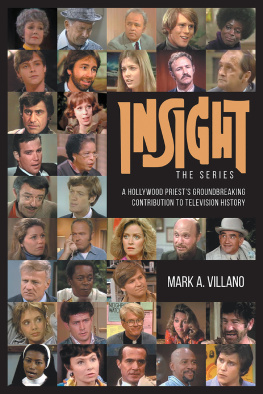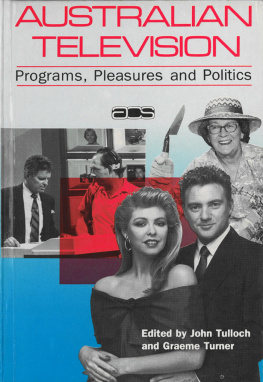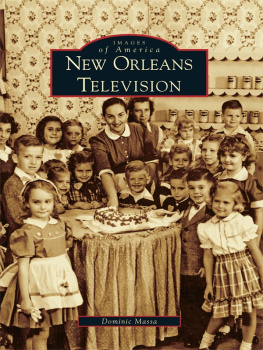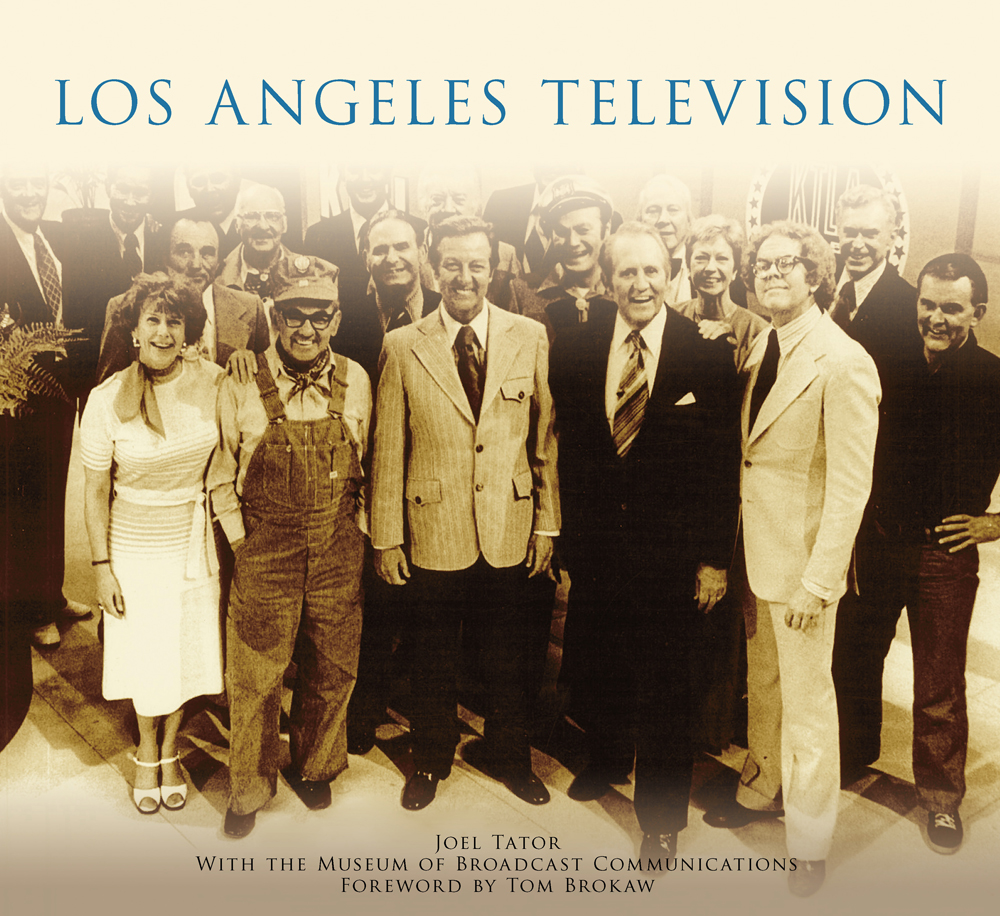
LOS ANGELES TELEVISION

The building pictured here atop the Hollywood sign would make local television history. (Authors collection.)
ON THE FRONT COVER: Los Angeles television pioneers gather for a taping celebrating the first 35 years of local television. They are identified on . (Courtesy of KTLA/Tom Hatten.)
ON THE BACK COVER: KTLA covered the first televised atom bomb detonation live. The story continues on . (Courtesy of KTLA.)
LOS ANGELES TELEVISION
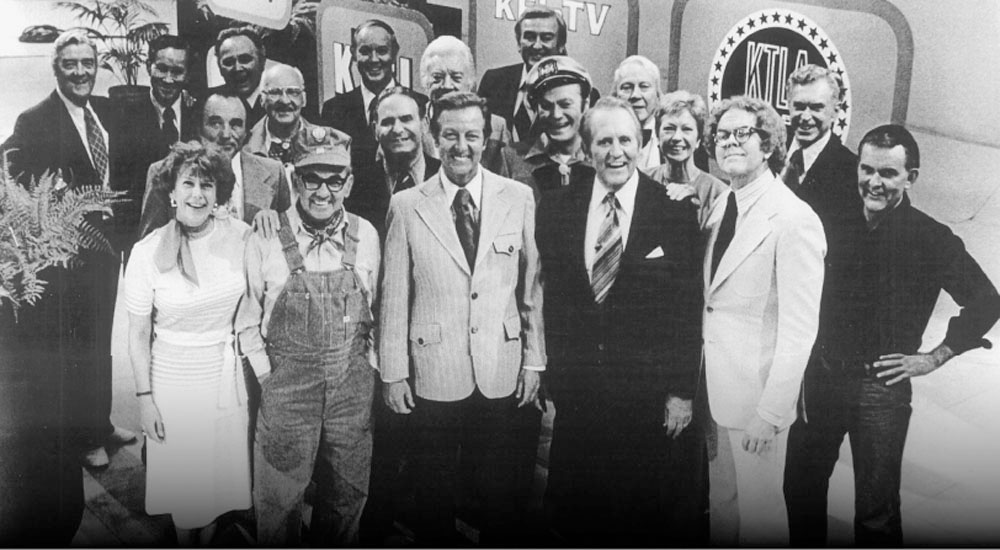
JOEL TATOR
WITH THE MUSEUM OF BROADCAST COMMUNICATIONS
FOREWORD BY TOM BROKAW
Copyright 2014 by Joel Tator with the Museum of Broadcast Communications
ISBN 978-1-4671-3270-1
Ebook ISBN 9781439649244
Published by Arcadia Publishing
Charleston, South Carolina
Library of Congress Control Number: 2014942580
For all general information, please contact Arcadia Publishing:
Telephone 843-853-2070
Fax 843-853-0044
E-mail
For customer service and orders:
Toll-Free 1-888-313-2665
Visit us on the Internet at www.arcadiapublishing.com
Dedicated with love to the men and women of Los Angeles television who helped fill the Southern California airwaves with entertainment and news since 1931
CONTENTS
FOREWORD
When local television began to explode across America in the mid-1960s, with a new generation of anchors, producers, and promoters, Southern California was a separate universe with its own culture, rules, and goals.
First, it was sprawl with no single defining center. Millions of people, most of who had immigrated to California in the postwar years, spread across thousands of square miles.
It was a challenge that depended on speed and mobility, so local stations had fleets of helicopters, motorcycles, and fast cars to get the film (yes, film) back to the station in those pre-satellite days. I often flew up to the San Francisco area in the morning to cover Haight-Ashbury or the free speech movement and got back to Burbank in time for the 6:00 p.m. news.
Because it was the entertainment center of the world, the local veteran anchors were not far removed from the studio culture. George Putnam on KTLA was larger than life, an outspoken conservative well before Fox News. Baxter Ward on KABC-TV was a master of the one-on-one style and the populist stories of the day. Clete Roberts was never without his Ray-Bans, his passport, and his stylish affability. Jerry Dunphy on the CBS station was the ratings leader with a leading-mans looks and a Rolls Royce as his car of choice.
As that began to change, a new generation of television journalists earned their stripes in Southern California, including yours truly, Tom Snyder, Bryant Gumbel, and Joe Benti. Simultaneously, the local news culture developed a new generation of the multiethnic character of the area, as well as a special focus on women.
Like the area itself, Southern California and local news has always been a dynamic presence in the land of natives and immigrants, showbiz and world-class universities, surf and mountains, and deserts and fertile valleys.
Tom Brokaw
ACKOWLEDGMENTS
Thank you to Bruce DuMont of the Museum of Broadcast Communications in Chicago for suggesting this project and Alyssa Jones and Mike Litchfield of Arcadia Publishing for overseeing it. Ellen Deutsch painstakingly made it look right.
I am grateful to Tom Brokaw, who kindly wrote the foreword in the midst of his busy schedule.
For their contributions and permissions of many of the stills, I thank John Moczulski of KTLA, Erin Chase and David Ziedberg at the Huntington Library, Jeff Pirtle at NBC Universal, Nora Bates at the Television Academy, Betty White, Jeff Witjas, David Schwartz, Bruce Henstell, Jerry Zelinger, Mitch Waldow, Marc Wanamaker, and Jake Lau. Unless otherwise noted, all images are from the authors collection.
For their invaluable support and help on the KTLA and KNXT anniversary shows, from which some stories in this book are excerpted, I am eternally grateful to Steve Skinner, Bonnie Tiegel, Matthew Pomeranz, Chip Bell, David Shipman, Evelyn De Wolfe, Cleve Landsberg, Scott Owens, and Tom Hatten.
At KTLA, thank you to the people who helped create the history: Gary Markas, Stan Chambers, Eric Spillman, Nick Van Hoogstraten, Steve Bell, Greg Nathanson, Terry Drinkwater, Warren Cereghino, Joe Quasarano, Ron Gaviati, Jay Wilson, Ron Major, Steve Dichter, Dave Moore, Gary Reyes, Dave Lopez, Dick Watson, Dick Lane, John Polich, Ed Resnick, Sam Rubin, Robert Dean, Ray Figelski, Ray Brune, Mike Conley, Pete Noyes, Bob Tarlau, and Rich Goldner.
At KNXT/KCBS, thank you to the following: Steve Edwards, Melody Rogers, Connie Chung, Larry Forsdick, Bill Stout, Bob Heitmann, Ralph Story, Larry Greene, Jay Strong, Pam Whitfield, Dan Gingold, Jack Chapman, Mike Hernandez, and Mike Herzmark.
At NBC, thank you to the following: Jess Marlow, Lee Schulman, Mort Werner, George Falardeau, Chris Watt, Peter Nichol, Jim Mancuso, and Kelly Lange.
Thank you to these longtime friends who sustained me: Tom Snyder, Gary Greene, Jack Terry, Julian Wolinsky, Mike Alcalay, Bruce McKay, Doug Grant, Mike McManus, and Rory Markas.
My deepest appreciation goes out to the finest writers I know: Bruce Cohn, Bob Irvine, and Nate Kaplan.
I would also like to extend my gratitude to TV-Radio Life magazine and its staff, who were always way ahead of their time.
I could not have completed this endeavor without the inspiration of brilliant videographers Van Carlson, Gary Caplin, Tony Zapata, and Mike Armijo, who took my dreams and transported them to the television screen.
Finally, everlasting thanks goes to my parents, Frances and Maurice, who, among many other blessings, moved our family out to Los Angeles. A thanks also goes to my brother Steve, who helps me make it through life.
Joel Tator
INTRODUCTION
In 1927, an inventor living in Los Angeles, Philo T. Farnsworth, created the first electronic television system in his home lab on New Hampshire Street in East Hollywood. He succeeded in transmitting a television picture of a young man. That first television star was Cliff Gardner, Farnsworths brother-in-law. In 1927, Prohibition was in full swing, and the Los Angeles Police Department once raided Farnsworths lab because it thought he was making illegal whiskey. Prohibition finally would go away, but television was here to stay.
Today, viewers in Los Angeles have hundreds of television channels to choose from. But in the beginning, there were only seven stations to watch. KTLA Channel 5 was the first to become a commercial station on January 22, 1947.
Generally speaking, most radio and television call letters began with a K west of the Mississippi and W in the east. The abbreviation TLA stood for Television Los Angeles. The next channel, which went live on May 6, 1948, was KTSL Channel 2. Those call letters, TSL, stood for Thomas S. Lee, the son of car dealer Don Lee who owned the station. Third was KLAC-TV Channel 13 on September 17, 1948. LAC stood for Los Angeles, California. On October 6, 1948, KFI-TV Channel 9 came on the air. FI stood for Farm Information, which its radio counterpart was originally known for. KTTV Channel 11 signed on January 1, 1949, with the broadcast of the Rose Parade. TTV stood for Times Television, as 51 percent of that station was owned by the
Next page

